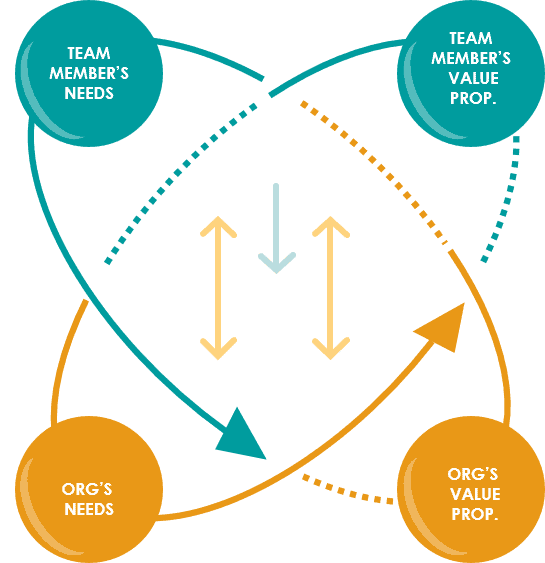A Human Resources leader was recently describing the talent challenges her organization was experiencing as a result of COVID-19. At this point, they’ll likely sound familiar: increasing workloads, job security concerns, and executive leadership “hints” about a near-term return to the office.
But this company was facing an extra curveball: they recently experienced a mass exodus of mid-level management who accepted offers from the same competitor. The offers included fully remote work for an office out of state. The HR leader approached Vantage for some advice on the role of leadership in how to retain and engage the “stayers” as the organization continues to change.
Virtually all organizations are facing workplace issues as the post-COVID world begins to take shape. Rather than viewing this situation as a threat, proactive organizations should consider it an opportunity to redefine their employment value proposition – which not only can retain top talent, but also attract it. Of course, proactive leadership amidst change isn’t as easy as it sounds.
Why? Because leaders understandably view change through the prism of what the organization needs while underestimating the impact of change on the individual and what they need. This often leads to the organization making demands on employees that can demotivate, disengage, or even cause them to depart. To address this dilemma, we encourage leaders to utilize Vantage Leadership’s Accelerated Development Model (ADM). The ADM provides leaders with a framework to better-align the needs and values across the organization and individuals, especially during times of change.

To best understand how the ADM can help leaders achieve this outcome, let’s consider the issue of “permanent” remote working, a topic that most organizations are either addressing now, or will be in the very near future.
The Challenge
Some organizations are allowing remote working arrangements, others are requiring employees to move back into the office in phases, and still others are setting a hard date for returning to in-person operations. Whether or not the decision is logical from an employee point of view, the challenge is aligning individual needs to those of the organization.
If a company fails to approach this thoughtfully, even the most logical decisions can be rejected culturally. Why? Employee needs have shifted, and many individuals would like to maintain the flexibility provided by remote working. A blanket deadline for returning to the office full-time might dampen employee engagement at best – and lead to unwanted turnover at worst. As the economy gears back up, people may be increasingly less willing to tolerate aspects of organizational culture that don’t work for them than they were in the early days of the pandemic. How then, can an organization address this emerging gap between organizational and individual needs?
The Solution
In this situation, the ADM could be used to consider the working arrangements the organization is willing to implement, and then position them idiosyncratically across teams. Specifically, how do employee needs align (or not) with what the organization has to offer? How do they feel about this, and what can the organization do to re-align employees with the evolving value proposition? Here’s an example of how these conversations can be structured within the ADM model framework.
Understanding Team Member’s Needs: What changes has the pandemic caused to make remote working arrangements so important?
Understanding Team Member’s Value Proposition: Why is the individual a valued member of the organization? What strengths and skills do they bring to the table? How is this value impacted by remote working arrangements?
Understanding the Organization’s Needs: Why does the organization feel it is important to have employees return to the office? Why is important internally? Why is it important to the customer?
Understanding the Organization’s Value Proposition: Why do individuals work at this organization? In addition to remote working, what other elements of the organization’s value proposition (e.g., culture, compensation, career development, purpose, etc.) align with the needs of the individual?
While transitioning from survival mode to the “new normal,” leaders should use this opportunity to have thoughtful conversations with their team members. This means communicating what the organization needs from them going forward, while also ensuring that the organization, in turn, understands what each individual needs.
As you navigate the slings and arrows of “To remote forever, or not to remote forever?,” we encourage you to experiment with the ADM to re-align with your employees – after all, the retention of your talent may depend on it.
How is your organization navigating the shift to the “new normal” of working arrangements? What is working, and what isn’t? Share with us in the comments below!
This post was co-authored by Amanda Bell.

